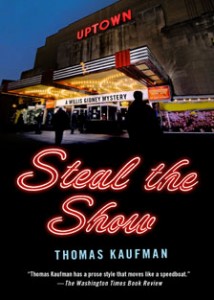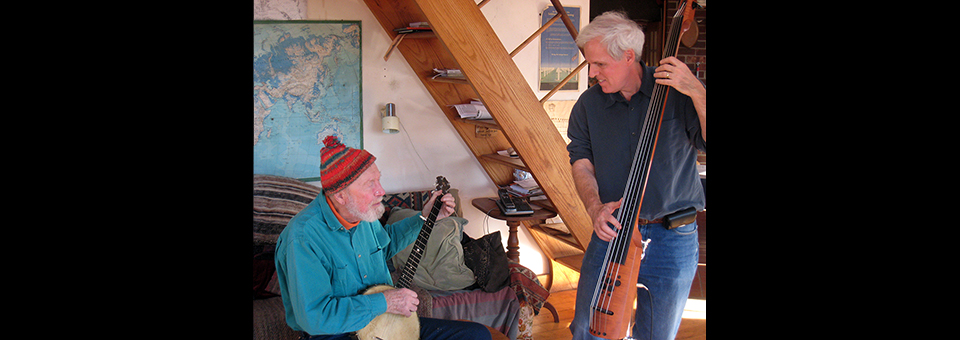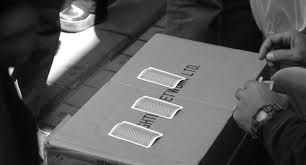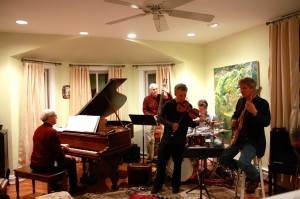I took a big risk when I met Pete Seeger. Read about it today at Algonquin Redux
The Art of the Scam
Conniving, low down dirty scam artists. That’s my post for today at Algonquin Redux. Have you ever been scammed? http://bit.ly/1j4b0aw
Jazz and Rusty Hassan
I’ve been listening to my favorite station, WPFW 89.3, and my favorite DJ, Rusty Hassan. 
When I first moved to DC many years ago, hearing Rusty was like getting a taste of home. A soothing voice, a great collection of music, and an encyclopedic knowledge of jazz — what more could you ask?
 My fictional private eye Willis Gidney seems to like Rusty too. In STEAL THE SHOW, my second PI novel, Gidney is committing a felony while thinking of listening to Rusty on his drive home. Talk about a fan!
My fictional private eye Willis Gidney seems to like Rusty too. In STEAL THE SHOW, my second PI novel, Gidney is committing a felony while thinking of listening to Rusty on his drive home. Talk about a fan!
Then I met Rusty at Takoma Park’s Jazzfest. I sent him a copy of STEAL THE SHOW and he invited me to come to his show. That’s tonight.
So what’ll we do? Despite my suggestion that I play the spoons while reciting the Constitution, Rusty said we’ll talk about jazz and the PI novel, I’ll read from one of the Gidney books, and then we’ll play some songs from the Willis Gidney Quintet. This group consists of Steve Mencher, John Shepherd, David Schulman, Alex Martin, and yours truly.
You didn’t know Willis has his own band? Not many fictional characters do, but the WGQ is a terrific jazz band that’s playing this weekend at the New Deal Cafe. C’mon down, if you like solid jazz from great players!
The business of business
Blogging today at Algonquin Redux about the business of business, check it out: http://bit.ly/HQQLNN
The Next Big Thing Blog Hop
THE NEXT BIG THING BLOG HOP
What is a blog hop? It’s a way for readers to discover authors new to them. I hope you’ll find new-to-you authors whose works you enjoy. On this stop on the blog hop, I’m interviewed about ERASED and Other Stories, a new collection coming this spring from Antenna Books. You’ll also find links to other authors you may enjoy reading.
My gratitude to fellow author E.A. Aymar for inviting me to participate. You can click the following link to learn more about E.A. and his work: http://www.eaymar.com
In this blog hop, I and my fellow authors, in their respective blogs, have answered questions about our book or work-in–progress (giving you a sneak peek). We’ve also included some behind-the-scenes information about how and why we write what we write–the characters, inspirations, plotting and other choices we make. I hope you enjoy it!
Please feel free to comment and share your thoughts and questions. Here is my Next Big Thing!
 1: How do you come up with the title of a book?
1: How do you come up with the title of a book?
Titles are tricky. At first I wanted to call my new work “Standard Oil of New Jersey,” but found out that’s already in use. So the title is “ERASED and Other Stories.” As you might guess, it’s a collection of short stories of mystery and suspense.
2: Where did the idea come from for the book?
I wanted to write a short story about my private eye, Willis Gidney, who graciously consented to appear in DRINK THE TEA, which won the PWA Competition for Best First Novel, and STEAL THE SHOW. I enjoyed writing the Gidney short story, and continued with more.
3. What genre does your book come under?
While Willis is part of the private eye genre, ERASED covers a wider territory. All the stories combine mystery and suspense, but I try to make the people in the stories a bit unusual, and their jobs even more so.
4: Which actors would you choose to play your characters in a movie rendition?
That’s a question I get asked a lot. There is an actor in Hollywood who would be terrific as Willis Gidney. I mean, he’d be absolutely perfect. But I’m not going to tell you his name. In the Gidney novels DRINK THE TEA and STEAL THE SHOW, I give the reader clues as to what Gidney looks like, but the readers have to create their own mental image of the guy. If I were to name an actor, then the readers will think of Gidney looking a particular way.
By the way, I think I would make a terrific Gidney. In fact, if I were younger, better looking, and had faster reflexes, we could be twins.
5: What is the one-sentence synopsis of your book?
ERASED is a collection of stories about twisted people doing twisted things.
6: Is your book self-published, published by an independent publisher, or represented by an agency?
My agent, Doug Grad, created Antenna Books as an epublishing venture. So ERASED is the first time I’ve written a book specifically for that market. Doug sent me a contract, 15 pages long. I’ll need to look it over with my agent before I sign.
7: How long did it take you to write the first draft of these stories?
Is that a trick question? I wrote most of these stories over four months, but went back and revised each one a few times. But I’m not counting the time that goes into thinking about and planning each story.
8: What other books would you compare this story to within your genre?
“Where’s Waldo?” comes to mind.
9: Who or what inspired you to write this book?
I work as a cinematographer and shoot a lot of documentaries. The lead story, ERASED, came from my experiences interviewing survivors of Nazi concentration camps. One of these survivors told me about a certain day: the Nazis rounded up all the adult Jews of a small Polish town, put them in trucks, and drove them miles away to work in the fields. When they returned, exhausted, they found that the Nazis had taken all of their children away, never to be seen again. My daughter had just been born and this story affected me like no other.
Also, as a novelist, I sometimes have ideas for stories that don’t quite justify a novel’s length. So rather than try to inflate a story to novel size, I let each story dictate its own length. You know, once upon a time the short story market was huge in the US. I wonder if epublishing will help bring the short story back?
10: What else about your book might pique the reader’s interest?
I think readers will find that the stories in ERASED cover a lot of ground – mystery, suspense, humor, tragedy. I’m writing the kind of stories I like to read, and hope others will like them too.
11: Why are you so much better-looking in person than in your photo?
It’s the team of make-up and hair people who follow me around all day. I’m not sure what happens to them at night.
Who’s next on the NEXT BIG THING BLOG HOP?
So glad you asked!
Below you will find authors who will be joining me by blog, next Wednesday. Do be sure to bookmark and add them to your calendars for updates on WIPs and New Releases:
Keith Gilman’s blog: http://keithgilman.com/
John Dedakis’s blog: http://www.johndedakis.com/blog/
Carolyn Mumford’s blog: http://carolynmulford.com/
I am Forest Whitaker
For a few seconds, I am Forest Whitaker
Sometimes when you read a script you see the letters POV. These letters do not mean Pills Or Vodka, or Place Over Vera, or even Putting on Velvet. They stand for Point of View, and POV is an effective way to get the audience to identify with a protagonist.
 Take the Hitchcock film NORTH BY NORTHWEST – Cary Grant gets kidnapped, and he looks to left. What’s he looking at, we wonder? Hitchcock cuts to Grant’s POV of the door handle, then cuts back to Grant as he tries to escape. That middle shot of the door handle is POV, and it gives the audience a moment to be Cary Grant.
Take the Hitchcock film NORTH BY NORTHWEST – Cary Grant gets kidnapped, and he looks to left. What’s he looking at, we wonder? Hitchcock cuts to Grant’s POV of the door handle, then cuts back to Grant as he tries to escape. That middle shot of the door handle is POV, and it gives the audience a moment to be Cary Grant.
Lee Daniels is an accomplished director, with movies like SHADOWBOXER, THE PAPERBOY, and PRECIOUS. His new film is THE BUTLER, starring Forest Whitaker and Oprah Winfrey. Whitaker plays a man who works as a White House butler from 1957 to 2009. This is based on a true story.
I’ve just spent part of the week with Raymond McIntyre, the visual effect supervisor for THE BUTLER. The interiors were shot on a sound stage, with green screen backings showing through the windows. My job? Shoot the background plates that Ray will composite with the sound stage footage.

Good enough, but Ray had another idea. “It’d be good to get a POV shot of Forest approaching the White House,” he told me, pulling out his iPad to show me what they had edited so far. Sure enough, you never really see the White House, as they were shooting these scenes outdoors in New Orleans. So, rather than airlift the White House down south (which a number of Republicans would like to do), Ray asked me to do a hand-held walking shot, to cut in with what they had.
Trouble was, we had no permit to film by the White House (and we always film, we never shoot). So we’d have to “steal” the shot. We got the camera ready, then simply walked along Pennsylvania Avenue till we got near the front gate. I started rolling and we got a few images before an official told us we had to leave. Later I showed Ray what I had and while it was good, Ray felt the camera angle was too wide – the White House wasn’t big enough or close enough in frame. So we went back and did it again. It was much better the second time, and no one informed us that we couldn’t do what we had just done.
Now the footage is in the edit room in New York, a tiny, infinitesimal part of the overall film Lee Daniels is making. When you see THE BUTLER (release date is November, 2013) you’ll probably not notice this shot – it’s only a few seconds. But for me it was magic. For those few seconds, I was Forest Whitaker, a young man approaching the White House for the very first time.
So now I’m wondering, what’s it like to be Cary Grant?
Willis Gidney…band leader?
No, he doesn’t sport a pencil mustache or walk around with a conductor’s baton, but private eye Willis Gidney is now — apparently — a band leader.
Just how does a fictional character do this?
[youtube url=”http://www.youtube.com/watch?v=s21r2VsAjIs” rel=”0″ showsearch=”0″]
It started two years ago, when Thomas met pianist Steve Mencher, and asked drummer John Shepherd to join them. The trio sounded great! Then they added David Shulman on violin and Alex Martin on guitar. After a few rehearsals the group knew they were ready to play out, to gig, but they had a problem — what to call the band?
All the names Thomas came up with were rock’n’roll band names, like THE ROUTERS or SHIMMY & the CHIMPS or AARDVARK & the BARFALOTS.
David said that jazz groups are typically named after the band leader.
“But we don’t have a leader,” Steve said.
“Let’s name the band after Willis Gidney,” Alex said.
They all looked to Thomas. “Uh, okay. Um. Great. Only problem is, he doesn’t actually exist.”
“Excellent,” John said. “That’ll be a big change from some of the real-life band leaders we’ve had.”
Thomas didn’t know how Willis would feel about this, but had a quick talk with him later.
“Are you up for this?” he asked the private eye.
“Is there any work involved?” Gidney asked.
“For us, yes. But not for you.”
“Then I’m okay with it,” Gidney said.
So if you’re near Greenbelt, Maryland this Halloween, please join the band at the New Deal Cafe. The band guarantees that their leader will NOT be there.
Music for the Soul
[youtube url=”http://www.youtube.com/watch?v=K9upxofATy0&feature=plcp” rel=”0″ showsearch=”0″ showinfo=”0″]
 Last year I read a book by Oliver Sacks, it was research for a new Willis Gidney book I am writing titled FACE THE MUSIC.
Last year I read a book by Oliver Sacks, it was research for a new Willis Gidney book I am writing titled FACE THE MUSIC.
In case you don’t know the name, Dr Sacks is a neurologist and a fine writer. His book AWAKENINGS was made into a film with Robert DeNiro , and Robin Williams played Dr Sacks.
Dr Sacks wrote a book about music and the brain, MUSICOPHILIA. He talks about the human brain’s plasticity, its ability to repair itself, to adapt to circumstances such as stroke. Music can help guide a patient to a higher quality of life.
But not just any music. No, it has to be music that is especially meaningful to the patient. For most of us, the most meaningful music of our lives is what we loved when we were teenagers and young adults.
 So, for someone born in the 1920’s, it could be the music of Tin Pan Alley. For me, it would probably be the Beatles.
So, for someone born in the 1920’s, it could be the music of Tin Pan Alley. For me, it would probably be the Beatles.
Gabby Giffords is the congresswoman from Arizona who was shot in the head some some crazed killer. Her wound was in some ways similar to a stroke. She couldn’t speak. But her favorite song was “Girls Just Want to Have Fun,” and music therapists found that if they sang the start of the song to Ms Giffords, she would join in with them. From this, the therapists were able to help Ms. Giffords begin to recover her speech.
A few weeks after reading Dr Sacks’s book, I was offered a job filming a story about an Alzheimer’s patient named Eleanor, and her benefiting from music therapy. THe place where this happened is called Centerlight, in the Bronx, and part of the facility houses the Institute for Music and Neurologic Function. This Institute was founded by Dr Sacks and Dr Connie Tomaino. You can see the finished video here.
Two things were striking: one was the ability of the music therapists to figure out what the important songs were for a given patient. It’s kind of like detective work — often the patient can’t speak, can’t tell the therapist “You know, if you played ‘When Irish Eyes Are Smiling,’ I’d be able to sing along with you.”
So the therapist has to make some educated guesses as to which songs might prove important enough to that patient to have him or her sing along.
The second thing is the change the brain goes through when music therapy is present. Eleanor, the woman I filmed, had been suffering from Alzheimer’s — she was paranoid, agitated, afraid, and had physically attacked members of her family. Once the music therapy began, her behavior changed. She was much calmer, happier, and her son and daughter-in-law were grateful for getting back someone they loved.
While there’s no cure for Alzheimer’s (yet), we can take steps to make the quality of life better for the victims. And at the same time, we can marvel at the human brain, and what it is capable of accomplishing.
A good day for reading “A Bad Day for Sorry”
You know you’re reading a great book when you don’t want it to end, and that’s what Sophie Littlefield has done with A BAD DAY FOR SORRY. How did she do it?
Well, for startes, she created a memorable hero, Stella Haredsty, then endowed her with admiraable traits: Stella is tough as a titanium nail, she’s brave, and she’s determined. Add to this a sense of humor and insight into human behavior, and you have an outstanding lead character. The supporting cast ain’t bad either. And although the cast is large, I was always sure who was who.
Then there’s the sense of place. I get the feeling Ms Littlefield really knows the town she;’s writing about, and the people who live there. My only complaint is that the book is ending. Ah well, there’s more in this series, which I plan to read as soon as possible.
Digital Improv
A Digital Collaboration: Improv Stories
Okay, I confess: I was part of an improve story group, organized by Gelati’s Scoop, an exceptional blog by Giovanni Gelati.
I met Giovanni through the internet, and he liked STEAL THE SHOW. When he contacted me about this new venture, I was intrigued. Here’s how it works:
Someone (in thi s case me) starts the story with three words supplied by Giovanni.In this case, my three words were: Bar, Dumpster, Library.I had about 90 minutes to write 1000-1500 words, then pass it along to the next sucker – oops, I mean writer.
s case me) starts the story with three words supplied by Giovanni.In this case, my three words were: Bar, Dumpster, Library.I had about 90 minutes to write 1000-1500 words, then pass it along to the next sucker – oops, I mean writer.
By noontime the story is finished.The Scoop gets other writers to read it and the authors have a chance to talk on his blogspot radio station.
So, how did I do this? Well, I felt comfortable with these words, maybe a little too easy, I thought.One thing – I’m playing with a new mystery novel, and part of it deals with the main character coming into a strange town. I wanted to use that same idea for this short story.
Have you ever driven across Texas?It is an enormous state, and depending on your route, could easily take you 24 hours to cross.I’ve made this drive at least 6 times, maybe a dozen, and in all kinds of weather. I guess in a state that big, you expect just about anything, including hail the size of footballs (it is Texas, of course).
Once, when I was new in the film business, I had to drive a van packed with lights and camera gear from LA to North Carolina.I got stranded in Texas, the roads were washed out by flooding.The highway patrol made us turn around, so I had a few hours to kill in this little town, the name of which escapes me.But I liked the idea of being forced to stay in one place, to feel as though nature were pressing in, keeping you constrained.So I did a little research and found that Burnet County has been flooded a number of times.
A bit more digging told me that the people in Burnet pronounce the name “burn it.”Too good to pass up, right?In fact, I titled the piece BURN IT (hey, I was the first person to write, so I get the name the story, okay?)
By the time you read this blog it will be available as a Kindle and Smashwords download. Drop me a line and let me know what you think. If you like it, thanks Gelati’s Scoop.








